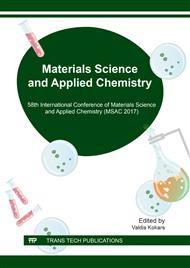[1]
V.V. Strelko, V.S. Kuts, P.A. Thrower, On the mehanism of possible influence of heteroatoms of nitrogen, boron and phosphorous in a carbon matrix on the catalytic activity of carbons in electron transfer reactions, Carbon, 38, (2000), 1499-1524.
DOI: 10.1016/s0008-6223(00)00121-4
Google Scholar
[2]
S. Biniak, G. Szymansky, J. Siedlewski, A. Swiatkowski, The characterization of activated carbons with oxygen and nitrogen surface groups, Carbon, 35, (1997), 1799-1810.
DOI: 10.1016/s0008-6223(97)00096-1
Google Scholar
[3]
K. Stanczyk, R. Dziembaj, Z. Piwowarska, S. Witkowski, Transformation of nitrogen structures in carbonization of model compounds determined by XPS, Carbon, 33, (1995), 1383-1392.
DOI: 10.1016/0008-6223(95)00084-q
Google Scholar
[4]
В.В. Стрелко, Механизм влияния гетероатомов на химию активных углей , В кн.: Селективная сорбция и катализ на активных углях и неорганических ионитах. – К.: Наук. думка, 2008, С. 5-44.
Google Scholar
[5]
В.С. Куць, В.Е. Клименко, В.В. Стрелко, Кластерные модели активного угля, В кн.: Селективная сорбция и катализ на активных углях и неорганических ионитах. – К.: Наук. думка, 2008, С. 45- 64.
Google Scholar
[6]
Yu.A. Tarasenko, A.A. Bagreev, G.V. Reznik, V.V. Strelko, Reductive sorption methods for noble metals extraction from solutions, Intern. symp. (conference) Hydrometallurgy'94, – Cambridge. 1994, 517-526.
DOI: 10.1007/978-94-011-1214-7_32
Google Scholar
[7]
A. Bagreev, J.A. Menendez, S. Kopyl, I. Dukhno, Yu. Zitsev, Yu. Tarasenko, T.J. Bandosz, Bituminous coal based activated carbons modified with nitrogen as adsorbents of hydrogen sulfide, Carbon, 42 (2004), 469-476.
DOI: 10.1016/j.carbon.2003.10.042
Google Scholar
[8]
S.V. Mikhalovsky, Yu.P. Zaitsev, Catalytic properties of activated carbons I. Gas-phase oxidation of hydrogen sulphide , Carbon, 35, (1997), 1367-1374.
DOI: 10.1016/s0008-6223(97)00104-8
Google Scholar
[9]
EASAC policy report 29 (2016). www. easac. eu.
Google Scholar
[10]
F. Su, Z. Tian, C.K. Poh, Z. Wang, S.H. Lim, Z. Liu, J. Lin, Pt Nanoparticles Supported on Nitrogen-Doped Porous Carbon Nanospheres as an Electrocatalyst for Fuel Cells. Chem. Mater., 22, (2010), 832-839.
DOI: 10.1021/cm901542w
Google Scholar
[11]
C.H. Choi, S.H. Park, M.W. Chung, S.I.I. Woo, Easy and controlled synthesis of nitrogen-doped carbon, Carbon, 55, (2013), 98-107.
DOI: 10.1016/j.carbon.2012.12.014
Google Scholar
[12]
S. Rasto, I. Kruusenberg, M. Vikkisk, U. Joost, E. Shulga, I. Kink, T. Kallio, K. Tammeveski, Highly active nitrogen – doped few-layer graphene/carbon nanotube composite electrocatalyst for oxygen reduction in alkaline media. Carbon, 73, (2014).
DOI: 10.1016/j.carbon.2014.02.076
Google Scholar
[13]
M.G. Adsul, M.S. Singhvi, S.A. Gaikaiwari, D.V. Gokhale, Development of biocatalysts for production of commodity chemicals from lignocellulosic biomass, Bioresource Technol., 102, (2011), 4304-4312.
DOI: 10.1016/j.biortech.2011.01.002
Google Scholar
[14]
R.C. Bansal and M. Goyal, Activated carbon adsorption. Taylor &Francis, (2005).
Google Scholar
[15]
H. Marsh and F. Rodriguez-Reinoso, Activated Carbon. Amsterdam: ElsevierScience, (2006).
Google Scholar


